Multispectral and Radar Data for the Setting of Gold Mineralization in the South Eastern Desert, Egypt
Abstract
1. Introduction
2. Geologic Setting
3. Remote-Sensing Data Processing
3.1. Data Characteristics and Methods
3.2. Pre-Processing of Satellite Data
3.3. Optical Data-Based Lithological Mapping
3.3.1. Band Ratios and Relative Absorption Band Depth
3.3.2. Mineralogical Indices
3.3.3. Principal and Independent Component Analyses (PCA and ICA)
3.4. SAR Data-Based Lineament Extraction
4. Gold Occurrences
4.1. Um Eleiga Gold Deposit
4.2. Hutit Gold Occurrence (Also Known as Huzama or Rahaba Mine)
4.3. Um Teneidab Gold Mine (Also Known as Um Kalieb or Um Kalieba Mine)
4.4. Urga Ryan Gold Occurrence
5. Discussion
6. Conclusions
Author Contributions
Funding
Acknowledgments
Conflicts of Interest
References
- Abdelsalam, M.G.; Stern, R.J. Sutures and shear zones in the Arabian-Nubian Shield. J. Afr. Earth Sci. 1996, 23, 289–310. [Google Scholar] [CrossRef]
- Abdelsalam, M.G.; Abdeen, M.M.; Dowidar, H.M.; Stern, R.J.; Abdelghaffar, A.A. Structural evolution of the Neoproterozoic western Allaqi-Heiani suture zone, Southern Egypt. Precambrian Res. 2003, 124, 87–104. [Google Scholar] [CrossRef]
- Johnson, P.R.; Andresen, A.; Collins, A.S.; Fowler, A.R.; Fritz, H.; Ghebreab, W.; Kusky, T.; Stern, R.J. Late Cryogenian–Ediacaran history of the Arabian–Nubian Shield: A review of depositional, plutonic, structural, and tectonic events in the closing stages of the northern East African Orogen. J. Afr. Earth Sci. 2011, 61, 167–232. [Google Scholar] [CrossRef]
- Stern, R.J.; Hedge, C.E. Geochronologic and isotopic constraints on late Precambrian crustal evolution in the Eastern Desert of Egypt. Am. J. Sci. 1985, 285, 97–127. [Google Scholar] [CrossRef]
- Noweir, A.M.; El-Amawy, M.A.; Rashwan, A.A.; Abdel-Aziz, A.M. Geology and structural evolution of the Pan-African basement rocks around Wadi Umm Araka, Northeast Wadi Allaqi, South Eastern Desert, Egypt. Egypt. J. Geol. 1996, 40, 477–512. [Google Scholar]
- Miller, M.M.; Dixon, T.H. Late Proterozoic evolution of the northern part of the Hamisana zone, northeast Sudan: Constraints on Pan-African accretionary tectonics. J. Geol. Soc. 1992, 149, 743–750. [Google Scholar] [CrossRef]
- Greiling, R.O.; Abdeen, M.M.; Dardir, A.A.; El Akhal, H.; El Ramly, M.F.; Kamal El Din, G.M.; Osman, A.F.; Rashwan, A.A.; Rice, A.H.N.; Sadek, M.F. A structural synthesis of the Proterozoic Arabian–Nubian Shield in Egypt. Geologische Rundschau 1994, 83, 484–501. [Google Scholar] [CrossRef]
- Sultan, M.; Arvidson, R.E.; Duncan, I.J.; Stern, R.J.; El Kaliouby, B. Extension of the Najd shear system from Saudi Arabia to the central Eastern Desert of Egypt based on integrated field and Landsat observations. Tectonics 1988, 7, 1291–1306. [Google Scholar] [CrossRef]
- Kusky, T.M.; Ramadan, T. Structural controls on Neoproterozoic mineralization in the south Eastern Desert, Egypt: An integrated field, Landsat TM, and SIR C/X approach. J. Afr. Earth Sci. 2002, 35, 107–121. [Google Scholar] [CrossRef]
- Zoheir, B.; Emam, A.; El-Amawy, M.; Abu-Alam, T. Auriferous shear zones in the central Allaqi-Heiani belt: Orogenic gold in post-accretionary structures, SE Egypt. J. Afr. Earth Sci. 2018, 146, 118–131. [Google Scholar] [CrossRef]
- Zoheir, B.; Emam, A. Integrating geologic and satellite imagery data for high-resolution mapping and gold exploration targets in the South Eastern Desert, Egypt. J. Afr. Earth Sci. 2012, 66, 22–34. [Google Scholar] [CrossRef]
- Zoheir, B.; Emam, A. Field and ASTER imagery data for the setting of gold mineralization in Western Allaqi–Heiani belt, Egypt: A case study from the Haimur deposit. J. Afr. Earth Sci. 2014, 99, 150–164. [Google Scholar] [CrossRef]
- Pour, A.B.; Hashim, M. Structural geology mapping using PALSAR data in the Bau gold mining district, Sarawak, Malaysia. Adv. Space Res. 2014, 54, 644–654. [Google Scholar] [CrossRef]
- Gabr, S.S.; Hassan, S.M.; Sadek, M.F. Prospecting for new gold-bearing alteration zones at El-Hoteib area, South Eastern Desert, Egypt, using remote sensing data analysis. Ore Geol. Rev. 2015, 71, 1–13. [Google Scholar] [CrossRef]
- Bannari, A.; El-Battay, A.; Saquaque, A.; Miri, A. PALSAR-FBS L-HH Mode and Landsat-TM Data Fusion for Geological Mapping. Adv. Remote Sens. 2016, 5, 246. [Google Scholar] [CrossRef]
- Amer, R.; El Mezayen, A.; Hasanein, M. ASTER spectral analysis for alteration minerals associated with gold mineralization. Ore Geol. Rev. 2016, 75, 239–251. [Google Scholar] [CrossRef]
- Emam, A.; Zoheir, B.; Johnson, P. ASTER-based mapping of ophiolitic rocks: Examples from the Allaqi–Heiani suture, SE Egypt. Int. Geol. Rev. 2016, 58, 525–539. [Google Scholar] [CrossRef]
- Emam, A.; Hamimi, Z.; El-Fakharani, A.; Abdel-Rahman, E.; Barreiro, J.G.; Abo-Soliman, M.Y. Utilization of ASTER and OLI data for lithological mapping of Nugrus-Hafafit area, South Eastern Desert of Egypt. Arabian J. Geosci. 2018, 11, 756. [Google Scholar] [CrossRef]
- Hassan, S.M.; Taha, M.M.; Mohammad, A.T. Late Neoproterozoic basement rocks of Meatiq area, Central Eastern Desert, Egypt: Petrography and remote sensing characterizations. J. Afr. Earth Sci. 2017, 131, 14–31. [Google Scholar] [CrossRef]
- Pour, A.B.; Hashim, M.; Makoundi, C.; Zaw, K. Structural Mapping of the Bentong-Raub Suture Zone Using PALSAR Remote Sensing Data, Peninsular Malaysia: Implications for Sediment-hosted/Orogenic Gold Mineral Systems Exploration. Res. Geol. 2016, 66, 368–385. [Google Scholar] [CrossRef]
- Pour, A.B.; Park, Y.; Park, T.Y.S.; Hong, J.K.; Hashim, M.; Woo, J.; Ayoobi, I. Regional geology mapping using satellite-based remote sensing approach in Northern Victoria Land, Antarctica. Polar Sci. 2018, 16, 23–46. [Google Scholar] [CrossRef]
- Amer, R.; Kusky, T.; Ghulam, A. Lithological mapping in the Central Eastern Desert of Egypt using ASTER data. J. Afr. Earth Sci. 2010, 56, 75–82. [Google Scholar] [CrossRef]
- Amer, R.; Kusky, T.; El Mezayen, A. Remote sensing detection of gold related alteration zones in Um Rus area, Central Eastern Desert of Egypt. Adv. Space Res. 2012, 49, 121–134. [Google Scholar] [CrossRef]
- Mars, J.C.; Rowan, L.C. ASTER spectral analysis and lithologic mapping of the Khanneshin carbonatite volcano, Afghanistan. Geosphere 2011, 7, 276–289. [Google Scholar] [CrossRef]
- Madani, A.A.; Emam, A.A. SWIR ASTER band ratios for lithological mapping and mineral exploration: A case study from El Hudi area, southeastern desert, Egypt. Arabian J. Geosci. 2011, 4, 45–52. [Google Scholar] [CrossRef]
- Sadek, M.F.; Ali-Bik, M.W.; Hassan, S.M. Late Neoproterozoic basement rocks of Kadabora-Suwayqat area, Central Eastern Desert, Egypt: Geochemical and remote sensing characterization. Arabian J. Geosci. 2015, 8, 10459–10479. [Google Scholar] [CrossRef]
- Asran, A.M.; Emam, A.; El-Fakharani, A. Geology, structure, geochemistry and ASTER-based mapping of Neoproterozoic Gebel El-Delihimmi granites, Central Eastern Desert of Egypt. Lithos 2017, 282, 358–372. [Google Scholar] [CrossRef]
- Abrams, M.J.; Brown, D.; Lepley, L.; Sadowski, R. Remote sensing for porphyry copper deposits in Southern Arizona. Econ. Geol. 1983, 78, 591–604. [Google Scholar] [CrossRef]
- Roy, D.P.; Wulder, M.A.; Loveland, T.R.; Woodcock, C.E.; Allen, R.G.; Anderson, M.C.; Helder, D.; Irons, J.R.; Johnson, D.M.; Kennedy, R.; et al. Landsat-8: Science and product vision for terrestrial global change research. Remote Sens. Environ. 2014, 145, 154–172. [Google Scholar] [CrossRef]
- Zhang, X.; Pazner, M.; Duke, N. Lithologic and mineral information extraction for gold exploration using ASTER data in the south Chocolate Mountains (California). ISPRS J. Photogramm. Remote Sens. 2007, 62, 271–282. [Google Scholar] [CrossRef]
- Crowley, J.K.; Brickey, D.W.; Rowan, L.C. Airborne imaging spectrometer data of the Ruby Mountains, Montana: Mineral discrimination using relative absorption band-depth images. Remote Sens. Environ. 1989, 29, 121–134. [Google Scholar] [CrossRef]
- Karnieli, A.; Meisels, A.; Fisher, L.; Arkin, Y. Automatic extraction and evaluation of geological linear features from digital remote sensing data using a Hough transform. Photogramm. Eng. Remote Sens. 1996, 62, 525–531. [Google Scholar]
- Kim, G.B.; Lee, J.Y.; Lee, K.K. Construction of lineament maps related to groundwater occurrence with ArcView and Avenue™ scripts. Comput. Geosci. 2004, 30, 1117–1126. [Google Scholar] [CrossRef]
- Arlegui, L.E.; Soriano, M.A. Characterizing lineaments from satellite images and field studies in the central Ebro basin (NE Spain). Int. J. Remote Sens. 1998, 19, 3169–3185. [Google Scholar] [CrossRef]
- Suzen, M.L.; Toprak, V. Filtering of satellite images in geological lineament analyses: An application to a fault zone in Central Turkey. Int. J. Remote Sens. 1998, 19, 1101–1114. [Google Scholar] [CrossRef]
- Hung, L.Q.; Dinh, N.Q.; Batelaan, O.; Tam, V.T.; Lagrou, D. Remote sensing and GIS-based analysis of cave development in the Suoimuoi catchment (Son La-NW Vietnam). J. Cave Karst Stud. 2002, 64, 23–33. [Google Scholar]
- Conoco Coral. Geological Map of Egypt, Scale 1:500,000, Bernice Sheet, NF 36 NE.; The Egyptian General Petroleum Corporation (EGPC): Cairo, Egypt, 1987. [Google Scholar]
- Nano, L.; Kontny, A.; Sadek, M.F.; Greiling, R.O. Structural evolution of metavolcanics in the surrounding of the gold mineralization at El Beida, South Eastern Desert, Egypt. Ann. Geol. Surv. Egypt 2002, 25, 11–22. [Google Scholar]
- Sadek, M.F. Geological and Structural Setting of Wadi Hodein Area Southeast Egypt with Remote Sensing Applications. In Proceedings of the International Archives of the Photogrammetry, Remote Sensing and Spatial Information Sciences, Beijing, China, 3–11 July 2008; Volume XXXVII-B8. [Google Scholar]
- Zoheir, B.A. Controls on lode gold mineralization, Romite deposit, South Eastern Desert, Egypt. Geosci. Front. 2012, 3, 571–585. [Google Scholar] [CrossRef]
- Sadek, M.F. Discrimination of basement rocks and alteration zones in Shalatein area, Southeastern Egypt using Landsat TM Imagery data. Egypt. J. Remote Sens. Space Sci. 2004, 7, 89–98. [Google Scholar]
- Abdeen, M.M.; Sadek, M.F.; Greiling, R.O. Thrusting and multiple folding in the Neoproterozoic Pan-African basement of Wadi Hodein area, south Eastern Desert, Egypt. J. Afr. Earth Sci. 2008, 52, 21–29. [Google Scholar] [CrossRef]
- Kontny, A.; Sadek, M.F.; Abdallah, M.; Marioth, R.; Greiling, R.O. First investigation on shear zone related gold mineralization at El Beida area, South Eastern Desert, Egypt. In Aspects of Pan-African Tectonics. International Cooperation, Bilateral Seminars International Bureau; De Wall, H., Greiling, R.O., Eds.; Forschungszentrum Julich: Jülich, Germany, 1999; Volume 32, pp. 91–97. [Google Scholar]
- Obeid, M.; Ali, M.; Mohamed, N. Geochemical exploration on the stream sediments of Gabal El Mueilha area, central Eastern Desert, Egypt: An overview on the rare metals. Res. Geol. 2001, 51, 217–227. [Google Scholar] [CrossRef]
- Kokaly, R.F.; Clark, R.N.; Swayze, G.A.; Livo, K.E.; Hoefen, T.M.; Pearson, N.C.; Klein, A.J. USGS Spectral Library Version 7 (No. 1035); US Geological Survey: Reston, VA, USA, 2017.
- Henderson, F.M.; Lewis, A.J. Principles and Applications of Imaging Radar. (Manual of Remote Sensing, Volume 2), 3rd ed.; Wiley: Hoboken, NJ, USA, 1998. [Google Scholar]
- J-Spacesystems. PALSAR User’s Guide, 2nd ed.; 2012; 69p, Available online: http://gds.palsar.ersdac.jspacesystems.or.jp/e/guide/ (accessed on 21 March 2019).
- Ma, J.; Xiao, X.; Qin, Y.; Chen, B.; Hu, Y.; Li, X.; Zhao, B. Estimating aboveground biomass of broadleaf, needleleaf, and mixed forests in northeastern China through analysis of 25-m ALOS/PALSAR mosaic data. For. Ecol. Manag. 2017, 389, 199–210. [Google Scholar] [CrossRef]
- ESA. Sentinel-1: ESA’s Radar Observatory Mission for GMES Operational Services; ESA SP-1322/1; European Space Agency: Paris, France, March 2012. [Google Scholar]
- Marghany, M.; Hashim, M. Lineament mapping using multispectral remote sensing satellite data. Int. J. Phys. Sci. 2010, 5, 1501–1507. [Google Scholar] [CrossRef]
- Bishta, A.Z.; Sonbul, A.R.; Kashghari, W. Utilization of supervised classification in structural and lithological mapping of Wadi Al-Marwah Area, NW Arabian Shield, Saudi Arabia. Arabian J. Geosci. 2014, 7, 3855–3869. [Google Scholar] [CrossRef]
- Flaash, U.S.G. Atmospheric Correction Module: QUAC and Flaash User Guide v. 4.7; ITT Visual Information Solutions Inc.: Boulder, CO, USA, 2009. [Google Scholar]
- Smith, M.J. A Comparison of DG AComp, FLAASH and QUAC Atmospheric Compensation Algorithms Using WorldView-2 Imagery. Master’s Dissertation, University of Colorado, Boulder, CO, USA, 2015. [Google Scholar]
- Cooley, T.; Anderson, G.P.; Felde, G.W.; Hoke, M.L.; Ratkowski, A.J.; Chetwynd, J.H.; Gardner, J.A.; Adler-Golden, S.M.; Matthew, M.W.; Berk, A.; et al. FLAASH, a MODTRAN4-based atmospheric correction algorithm, its application and validation. In Proceedings of the IEEE International Geoscience and Remote Sensing Symposium, Toronto, ON, USA, 24–28 June 2002; Volume 3, pp. 1414–1418. [Google Scholar]
- Gelautz, M.; Frick, H.; Raggam, J.; Burgstaller, J.; Leberl, F. SAR image simulation and analysis of alpine terrain. ISPRS J. Photogramm. Remote Sens. 1998, 53, 17–38. [Google Scholar] [CrossRef]
- Franceschetti, G.; Lanari, R. Synthetic Aperture Radar Processing; Electronic Engineering Systems Series; CRC Press: Boca Raton, FL, USA, 1999. [Google Scholar]
- Lee, J.S.; Jurkevich, L.; Dewaele, P.; Wambacq, P.; Osterlinck, A. Speckle filtering of synthetic aperture radar images: A review. Remote Sens. Rev. 1994, 8, 313–340. [Google Scholar] [CrossRef]
- Sveinsson, J.R.; Benediktsson, J.A. Speckle reduction and enhancement of SAR images in the wavelet domain. In Proceedings of the IGARSS’96, 1996 International Geoscience and Remote Sensing Symposium, Lincoln, NE, USA, 31 May 1996; Volume 1, pp. 63–66. [Google Scholar]
- Jensen, J.R. Introductory Image Processing: A Remote Sensing Perspective; Prentice Hall: New York, NY, USA, 1996. [Google Scholar]
- Glikson, A.Y. Mineral-Mapping in the North Pilbara Craton. In A Directed Principal Components of the Band Ratios Method for Correlating Landsat-5 Thematic Mapper Spectral Data with Geology: AGSO-Australian Geol. Survey Organisation Research Newsletter; AGSO: Canberra City, ACT, Australia, 1997; Volume 26, pp. 1–4. [Google Scholar]
- Sabins, F.F. Remote sensing for mineral exploration. Ore Geol. Rev. 1999, 14, 157–183. [Google Scholar] [CrossRef]
- Inzana, J.; Kusky, T.; Higgs, G.; Tucker, R. Supervised classifications of Landsat TM band ratio images and Landsat TM band ratio image with radar for geological interpretations of central Madagascar. J. Afr. Earth Sci. 2003, 37, 59–72. [Google Scholar] [CrossRef]
- Zumsprekel, H.; Prinz, T. Computer-enhanced multispectral remote sensing data: A useful tool for the geological mapping of Archean terrains in (semi) arid environments. Comput. Geosci. 2000, 26, 87–100. [Google Scholar] [CrossRef]
- Ninomiya, Y. A stabilized vegetation index and several mineralogic indices defined for ASTER VNIR and SWIR data. In Proceedings of the IGARSS 2003, 2003 IEEE International Geoscience and Remote Sensing Symposium. Proceedings (IEEE Cat. No. 03CH37477), Toulouse, France, 21–25 July 2003; Volume 3, pp. 1552–1554. [Google Scholar]
- Ninomiya, Y.; Fu, B.; Cudahy, T.J. Detecting lithology with Advanced Spaceborne Thermal Emission and Reflection Radiometer (ASTER) multispectral thermal infrared “radiance-at-sensor” data. Remote Sens. Environ. 2005, 99, 127–139. [Google Scholar] [CrossRef]
- Bonn, F.; Rochon, G. Précis de télédétection, vol. 1 Principes et méthodes; AUPELF-UREF, Collection Presses Universitaires du Quebec: Montreal, QC, Canada, 1992. [Google Scholar]
- Klemm, D.; Klemm, R.; Murr, A. Gold of the Pharaohs–6000 years of gold mining in Egypt and Nubia. J. Afr. Earth Sci. 2001, 33, 643–659. [Google Scholar] [CrossRef]
- Klemm, R.; Klemm, D. Gold and Gold Mining in Ancient Egypt and Nubia, Geoarchaeology of the Ancient Gold Mining Sites in the Egyptian and Sudanese Eastern Deserts; Springer: Berlin/Heidelberg, Germany, 2013; 663p. [Google Scholar]
- Hassan, O.A.; El-Manakhly, M.M. Gold deposits in the southern Eastern Desert, Egypt. In A commodity Package; Egyptian Geological Survey and Mining Authority: Cairo, Egypt, 1986. [Google Scholar]
- Gabra, S.Z. Gold in Egypt: A Commodity Package; 86 Pages, 11 Figures, 8 Maps; Geological Survey of Egypt: Cairo, Egypt, 1986.
- Zoheir, B.A.; Mehanna, A.M.; Qaoud, N.N. Geochemistry and geothermobarometry of the Um Eleiga Neoproterozoic island arc intrusive complex, SE Egypt: Genesis of a potential gold-hosting intrusion. Appl. Earth Sci. 2008, 117, 89–111. [Google Scholar] [CrossRef]
- Takla, M.A.; El Dougdoug, A.A.; Gad, M.A.; Rasmay, A.H.; El Tabbal, H.K. Gold-bearing quartz veins in mafic and ultramafic rocks, Hutite and Um Tenedba, south Eastern Desert, Egypt. Ann. Geol. Surv. Egypt 1995, 20, 411–432. [Google Scholar]
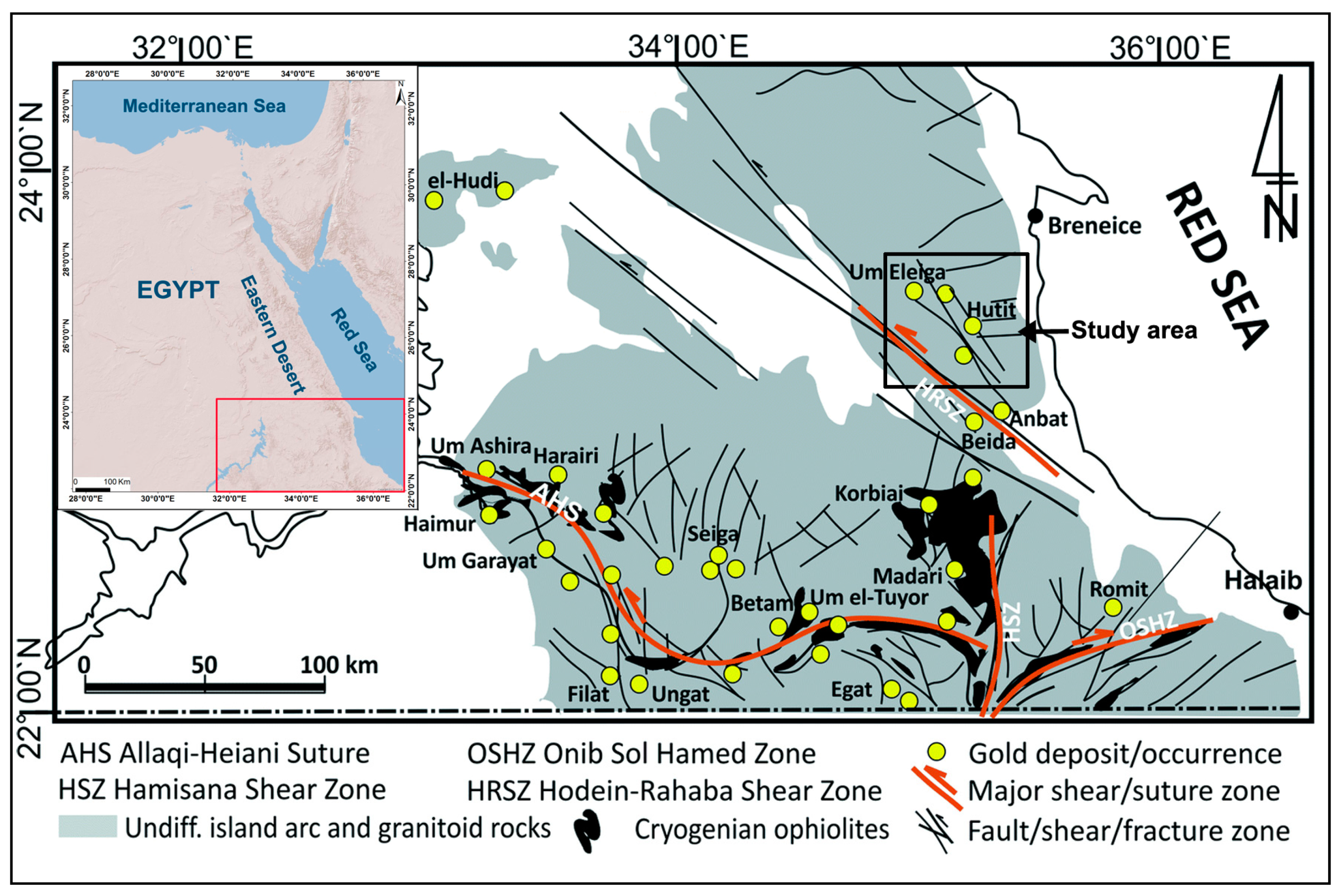
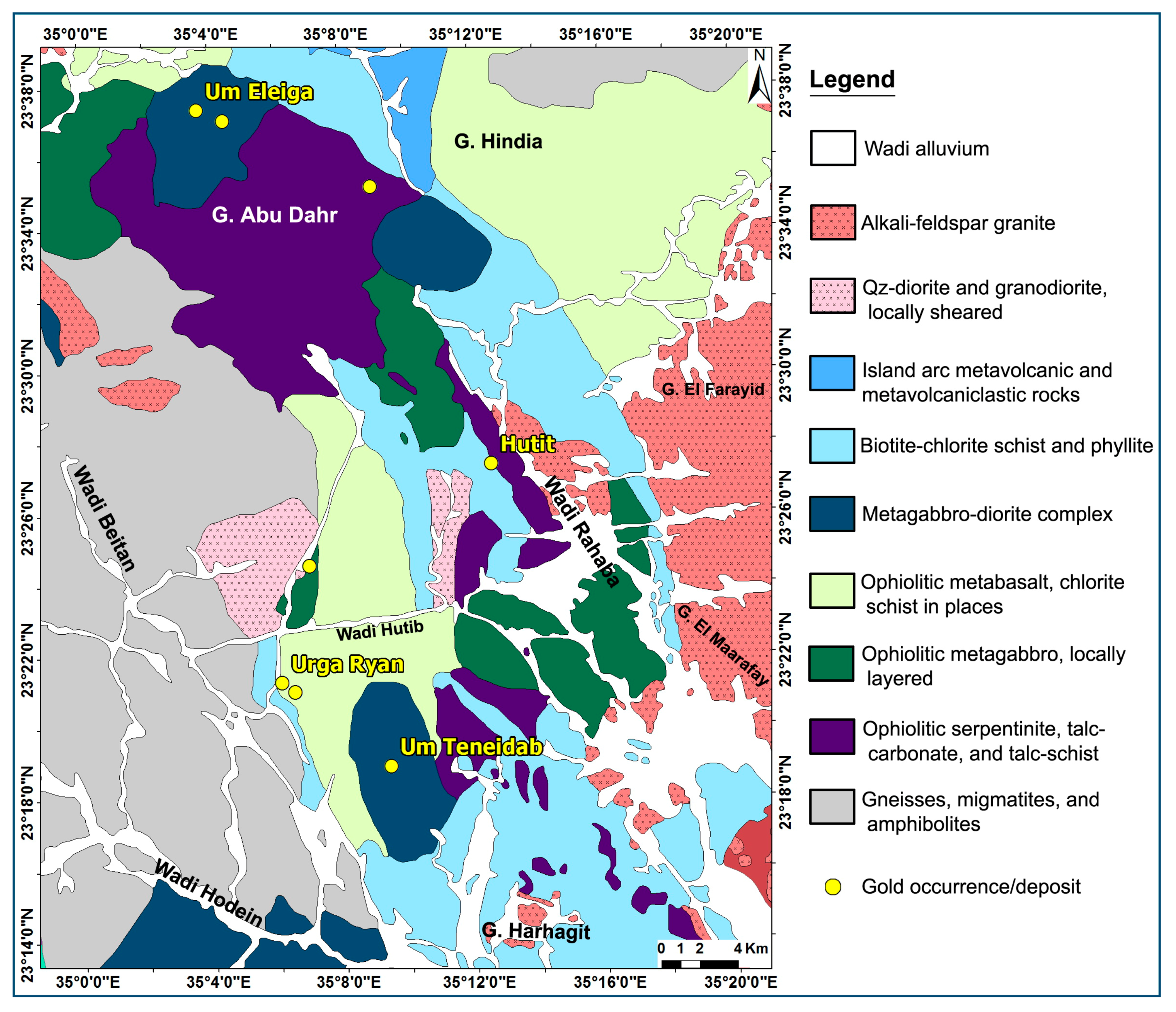








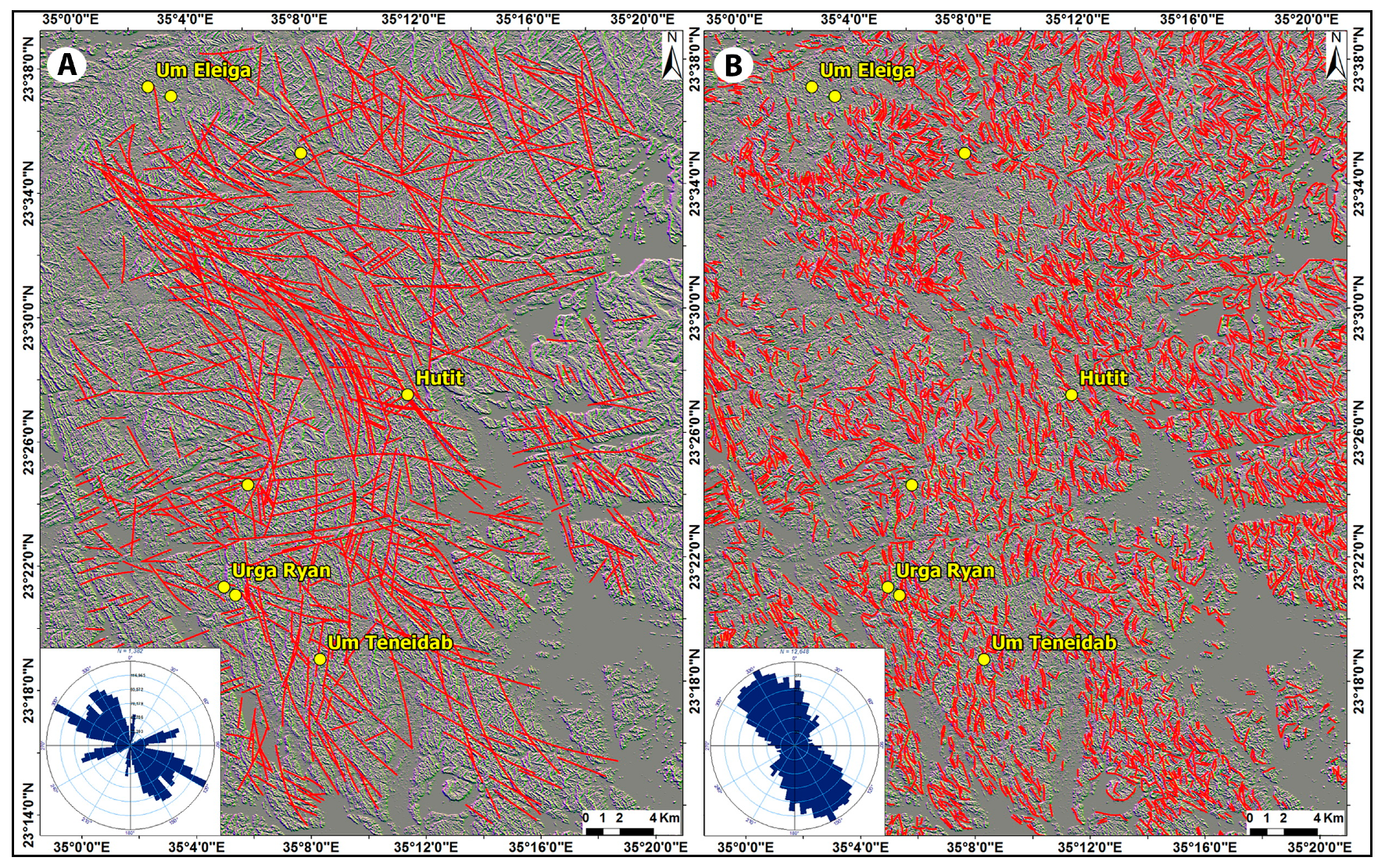
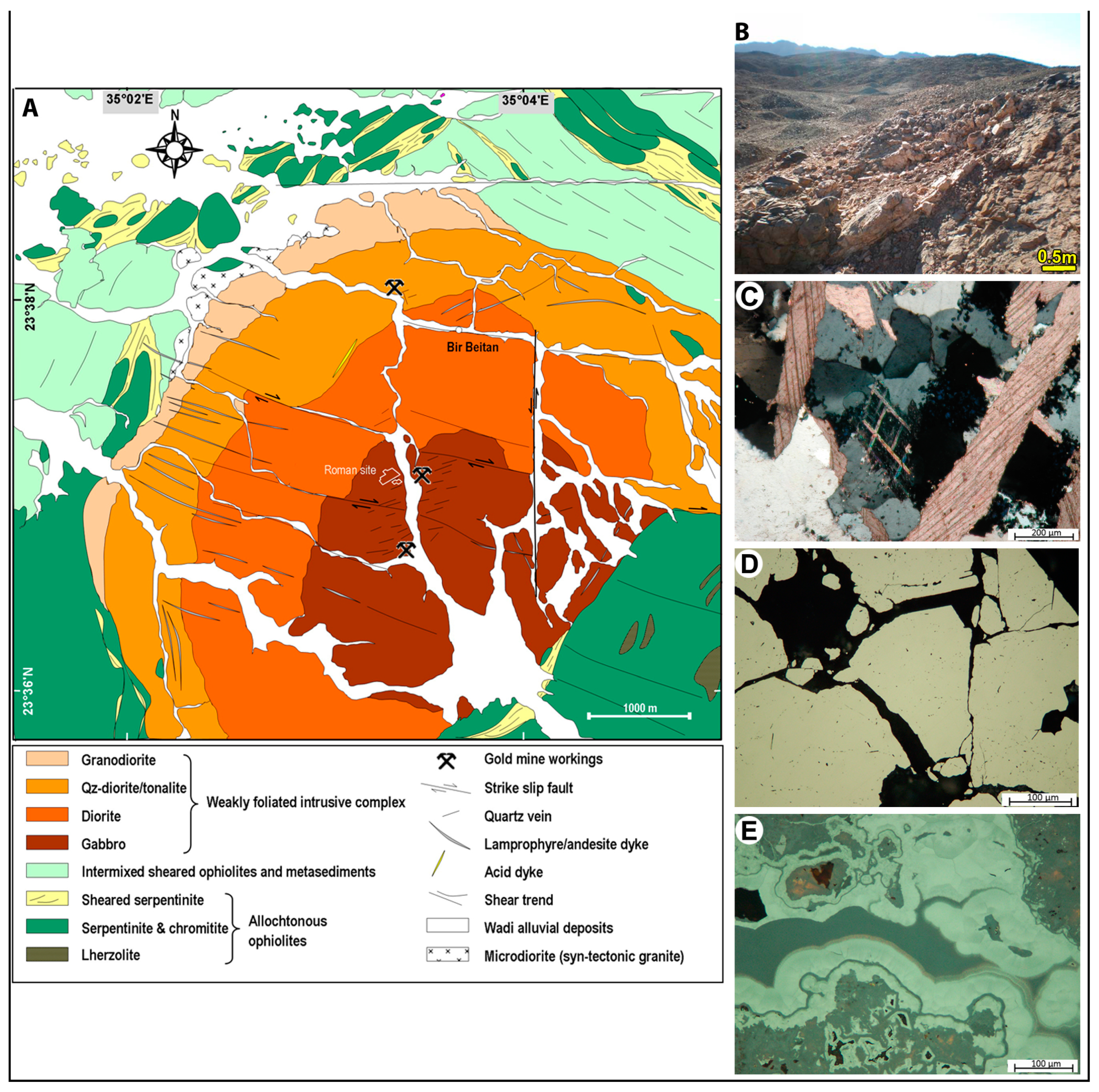
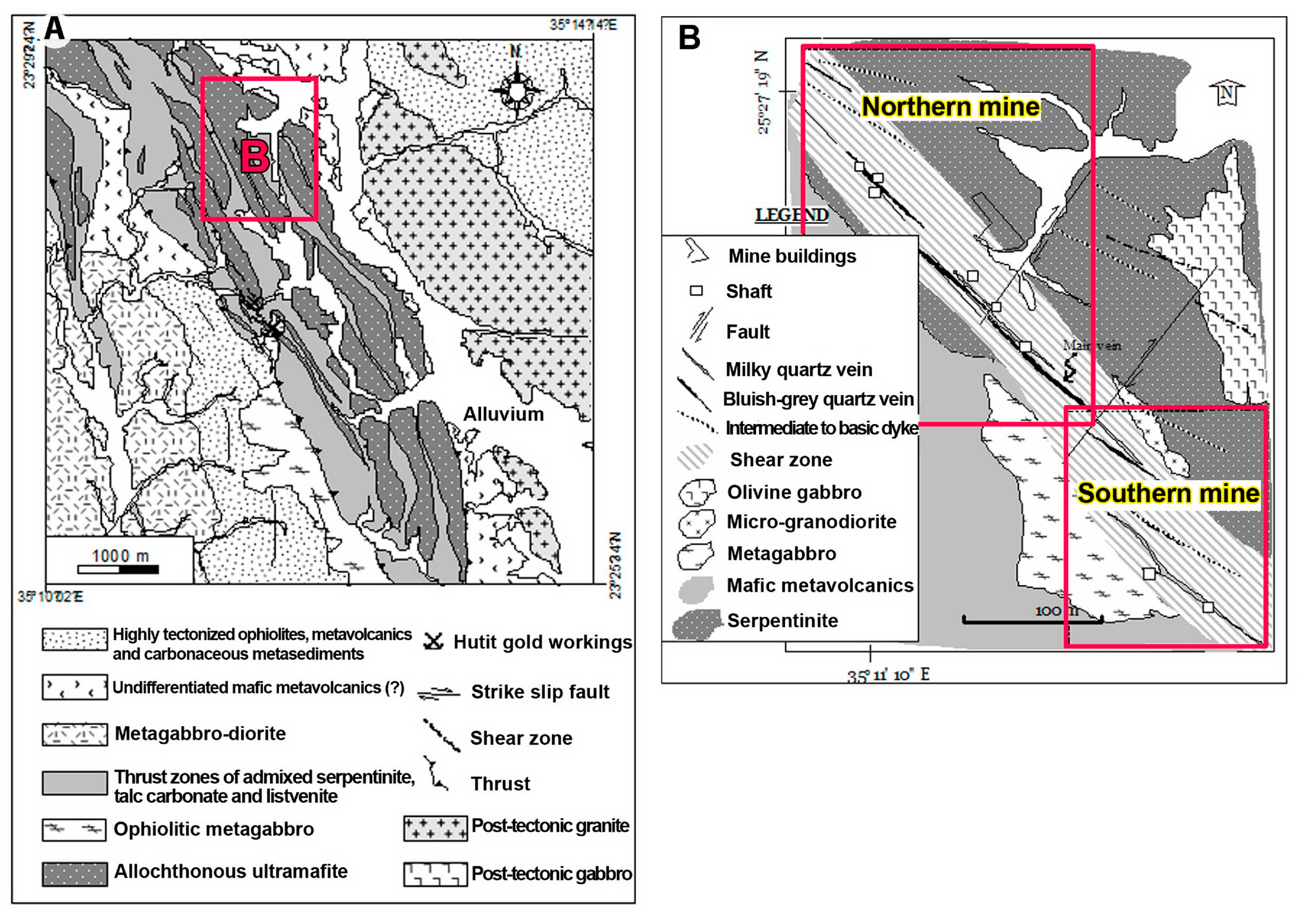




| Aster | Landsat-8 OLI/TIRS | ||||||
|---|---|---|---|---|---|---|---|
| Bands | Spectral Region | Wavelength (µm) | Resolution (m) | Bands | Spectral Region | Wavelength (µm) | Resolution (m) |
| Band 1 | VNIR | 0.52–0.60 | 15 | Band 1 | Coastal | 0.433–0.453 | 30 |
| Band 2 | 0.63–0.69 | Band 2 | Blue | 0.450–0.515 | |||
| Band 3 | 0.78–0.86 | Band 3 | Green | 0.525–0.600 | |||
| Band 4 | SWIR | 1.60–1.70 | 30 | Band 4 | Red | 0.630–0.680 | |
| Band 5 | 2.145–2.185 | Band 5 | NIR | 0.845–0.885 | |||
| Band 6 | 2.185–2.225 | Band 6 | SWIR | 1.560–1.660 | |||
| Band 7 | 2.235–2.285 | Band 7 | 2.100–2.300 | ||||
| Band 8 | 2.295–2.365 | Band 8 | Panchromatic | 0.500–0.680 | 15 | ||
| Band 9 | 2.360–2.430 | Band 9 | Cirrus | 1.360–1.390 | 30 | ||
| Band 10 | TIR | 8.125–8.475 | 90 | Band 10 | TIR | 10.60–11.19 | 100 |
| Band 11 | 8.475–8.825 | Band 11 | 11.50–12.51 | ||||
| Band 12 | 8.925–9.275 | ||||||
| Band 13 | 10.25–10.95 | ||||||
| Band 14 | 10.95–11.65 | ||||||
| Eigenvector | Fe–Mg-OH | QI | (5 + 7)/6 | (6 + 9)/82 | (6/7) | (4/5) | (4/2) | (5/6) | Var.% |
|---|---|---|---|---|---|---|---|---|---|
| PC1 | −0.492 | −0.276 | −0.013 | 0.480 | 0.313 | 0.375 | −0.419 | 0.193 | 44.4 |
| PC2 | 0.011 | −0.618 | −0.746 | −0.173 | −0.001 | −0.084 | 0.081 | −0.135 | 19.8 |
| PC3 | 0.135 | 0.027 | −0.078 | −0.068 | 0.537 | −0.017 | 0.452 | 0.691 | 16.3 |
| PC4 | −0.240 | −0.101 | 0.176 | 0.135 | 0.398 | −0.822 | −0.041 | −0.218 | 7.8 |
| PC5 | −0.202 | −0.158 | 0.046 | −0.052 | −0.596 | −0.367 | −0.202 | 0.631 | 5.7 |
| PC6 | −0.041 | 0.651 | −0.626 | 0.372 | −0.048 | −0.172 | −0.101 | 0.048 | 2.9 |
| PC7 | 0.016 | −0.209 | 0.100 | 0.677 | −0.304 | −0.001 | 0.623 | −0.088 | 1.9 |
| PC8 | −0.800 | 0.198 | −0.046 | −0.343 | −0.074 | 0.113 | 0.416 | −0.103 | 1.2 |
| Eigenvector | VV + VH | VV − VH | VV/VH | VV + VH/VH | VV − VH/VH | Var.% |
|---|---|---|---|---|---|---|
| PC1 | −0.030 | 0.567 | −0.568 | −0.480 | 0.353 | 47.29 |
| PC2 | 0.463 | 0.353 | −0.356 | 0.329 | −0.653 | 30.28 |
| PC3 | 0.810 | −0.222 | 0.209 | −0.492 | 0.093 | 20.05 |
| PC4 | −0.358 | −0.083 | 0.071 | −0.648 | −0.664 | 2.34 |
| PC5 | 0.005 | 0.706 | 0.709 | −0.010 | −0.006 | 0.05 |
| Eigenvector | HH + HV | HH − HV | HH/HV | HH + HV/HV | HH − HV/HV | Var.% |
|---|---|---|---|---|---|---|
| PC1 | 0.205 | −0.013 | 0.562 | 0.569 | 0.564 | 60.19 |
| PC2 | 0.441 | 0.894 | −0.054 | −0.045 | −0.040 | 20.59 |
| PC3 | 0.874 | −0.448 | −0.109 | −0.106 | −0.113 | 17.64 |
| PC4 | −0.003 | −0.010 | −0.761 | 0.121 | 0.637 | 1.20 |
| PC5 | 0.005 | −0.002 | 0.300 | −0.805 | 0.512 | 0.39 |
| Parameter | Value (pixel) |
|---|---|
| Edge filter radius | 5 |
| Edge gradient threshold | 20 |
| Curve length threshold | 30 |
| Line fitting error threshold | 2 |
| Angular difference threshold | 15 |
| Linking distance threshold | 40 |
| Method | Visual Extraction | Automated Extraction | |
|---|---|---|---|
| Used Data | RGB PC Images and Filters | Filtered PALSAR PC2 | Filtered Sentinel PC3 |
| Count | 691 | 6324 | 7062 |
| Minimum | 0.49 | 0.38 | 0.34 |
| Maximum | 11.96 | 3.78 | 3.47 |
| Sum | 1949.07 | 4307.17 | 4448.77 |
| Mean | 2.82 | 0.68 | 0.63 |
| Standard Deviation | 1.74 | 0.33 | 0.30 |
© 2019 by the authors. Licensee MDPI, Basel, Switzerland. This article is an open access article distributed under the terms and conditions of the Creative Commons Attribution (CC BY) license (http://creativecommons.org/licenses/by/4.0/).
Share and Cite
Zoheir, B.; Emam, A.; Abdel-Wahed, M.; Soliman, N. Multispectral and Radar Data for the Setting of Gold Mineralization in the South Eastern Desert, Egypt. Remote Sens. 2019, 11, 1450. https://doi.org/10.3390/rs11121450
Zoheir B, Emam A, Abdel-Wahed M, Soliman N. Multispectral and Radar Data for the Setting of Gold Mineralization in the South Eastern Desert, Egypt. Remote Sensing. 2019; 11(12):1450. https://doi.org/10.3390/rs11121450
Chicago/Turabian StyleZoheir, Basem, Ashraf Emam, Mohamed Abdel-Wahed, and Nehal Soliman. 2019. "Multispectral and Radar Data for the Setting of Gold Mineralization in the South Eastern Desert, Egypt" Remote Sensing 11, no. 12: 1450. https://doi.org/10.3390/rs11121450
APA StyleZoheir, B., Emam, A., Abdel-Wahed, M., & Soliman, N. (2019). Multispectral and Radar Data for the Setting of Gold Mineralization in the South Eastern Desert, Egypt. Remote Sensing, 11(12), 1450. https://doi.org/10.3390/rs11121450






